American Sabbatical 86: 4/5/97
Civil Rights
4/5.. Monroeville.
Breakfast at Joe and Pat’s again featured fresh baking, and we decided we’d better escape
quickly, before we begged to be adopted. We put on our feathers
and started to beat wings out of Fairhope. But which way?
The thought of more flatlands, or holiday crowds, made arriving
in New Orleans this week less tantalizing than it had been. Hills
and backroads beckoned sweetly. Peggy wanted to visit Monroeville,
Alabama, where Harper Lee wrote To Kill A Mockingbird. It’s about
an hour’s drive northeast of Mobile. Maybe it was time to zig.
A hard southerly was thrashing the trees, so we turned our backs
to it and blew upcountry.
We stopped on the way to visit Momma Dot at a hospital in Daphne,
just up the Mobile Bay shore. She was eager to talk to Peggy,
but was scheduled for therapy, so we unbagged our laundry at a
local suds-and-spin, and endured the ennui of watching fabrics
tumble. Then Peggy and Dot traded teacher-talk for a couple of
hours.
By the time we cleared Mobile Bay the ceiling was brushing our
hairdos, walls of turbulent black clouds were moving in on us,
and scattered drops splattered Owl’s face. We sidestepped onto
the sideroads, and the country, even in this ominous light, was
beautiful. Nobody warned us that Alabama can seduce you with her
passionate vegetation, and the roll of her hills. And armadillos?
Had we been advised about armadillos?
I’d imagined sharecroppers shacks, worn out cotton land, holloweyed
crackers, and mean dogs. Instead we get rippling green pastures,
dense stands of tall hardwoods, ridgetop vistas of receding treelines,
and tidy houses hunkered in shady groves. There’s rural poverty,
to be sure, shotgun houses teetering on blocks, with matching
parts cars, and abandoned looking tin boxes, mobile or traditional,
with dooryards awash in litter. But they are infrequent. Most
of the old houses are maintained with pride: the modest hiproofed
single-story-with-porch, as well as the antibellum-style manses,
pillars and pediments and all. And undemonstrative churches everywhere.
Gas stop in the crossroads town of Uriah. Old molded cement-block
post office and general store, with silver-white metal roofs and
porch awnings reaching down low to let the rain sluice wide. The
very image of the old rural South. And the sky opens up.
Spring rain in Dixie. Coming straight down in torrents. We limp
along, wipers slapping, working the defrost to cut the steam,
then the blowers to dry the sweat. Eating oranges and peering
at the roadsigns. The yellow-orange clay looks rich and oozy.
The ditches run like blood.
Downpour. Then the blackness lifts and it’s just raining. Then
downpour again. By the time we make Monroeville, the Courthouse
Museum is closed, the town is shut up, the water is standing deep
everywhere, and our slopping around in the puddles only gets our
feet wet. We quarter the downtown blocks looking for scenes out
of the book, visit the elementary school, and finally abandon
the quest for a dry room and a warm phonejack.
(Memo #76)
April 5 Harper Lee Monroeville
Who? author of To Kill a Mockingbird
What? author’s hometown used as model for book’s setting
Where? in south central Alabama
When? Pulitzer Prize winning book set in 1930’s, written in 1960’s
How? Harper Lee drew on her own life and hometown
Topics: Southern literature, setting, fame and tourism
Questions: How accurately has Harper Lee portrayed her home town?
Does the town of Monroeville capitalize on her book?
|
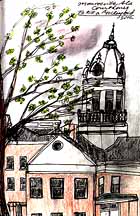
County Courthouse
|
I don’t know what I expected at Monroeville, Alabama, perhaps
another Hannibal, Missouri. Mark Twain’s hometown has so hyped
his books and characters that there are signs on Hannibal street
corners explaining what Huck and Tom did nearby. The whole town
seems to be involved in a conspiracy to convince visitors that
the events and characters in Twain’s books were all real. Would
there be Scout and Jem statues in the courthouse square in Monroeville?
Would Harper Lee’s house and settings be identified on cutesy
tourist maps? Would children’s overalls be described as being
“like Scout’s”? How does a Pulitzer Prize winning book affect
a small town in Alabama? Harper Lee’s characters and setting are
so vivid and real to me (even after thirty years) that I expected
to have a constant shock of recognition in her hometown.
I did research on Harper (“Nelle”) Lee before we set out on this
trip. Related somehow to Robert E. Lee, she was born and raised
in Monroeville where her father Amasa Lee (the model for Atticus
Finch) was a lawyer. “My father is one of the few men I’ve known
who has genuine humility, and it lends him a natural humility.
He has absolutely no ego drive, and so he is one of the most beloved
men in this part of the state.” She and her sister both studied
law at the University of Alabama. Ms. Lee moved to New York City
and worked for an airline while writing Mockingbird. One wonderful
article photographed her in her hometown - in the balcony of the
courthouse where she watched her father argue cases (like Scout)
, at the Old Hodge place (a haunted house that may have been the
model for the Radley home), in the schoolyard. “The trial (in
the book) was a composite of all trials in the world - some in
the South. But the courthouse was this one. My father’s a lawyer,
so I grew up in this room, and mostly I watched him from here.”
The quirky boy who comes to visit his Aunt for the summer was
apparently the young Truman Capote. My research turned up no information
about any other books she wrote after Mockingbird or what she
did after the 1960’s. Still, it was enough to make me go to Monroeville.
We drove north to Monroeville through rolling green farmland and
forests. A modern strip mall lead us toward town. As we entered
the town center, we saw the old elementary school (was that the
schoolyard where Scout and Jem were stalked?). We pulled into
courthouse square in Monroeville just after 2 pm on a Saturday.
There were few cars on the streets and many of the buildings that
edge the square were empty. It was pouring rain. The museum was
closed. The red brick courthouse in the center of the square was
closed, but there was a sign identifying it as the setting in
Ms. Lee’s book. A sign on the museum said you could buy tickets
to the play of “To Kill A Mockingbird”. There was no other information
(time? date?) available.
We drove back and forth around town looking for....tour signs
or a bookstore featuring her book or a Mockingbird Cafe. Nothing.
I began looking for old houses, haunted houses, a picturesque
jail (like the one where Atticus sat to protect Tom). The Monroeville
police station is right by the square but it is a large, modern,
brick building
(no barred windows visible). The houses are mostly low 1930’s
bungalows with deep porches. It is a quiet unremarkable town.
The town square does have a Katherine Lee Rose garden with no
explanation. I took a few pictures. Frustrating.
When we checked into our motel, I asked the receptionist if the
town did much to note Harper Lee’s success. “Not really,” she
said. “We kind of just grow up with it.” She knew nothing more
about Ms. Lee. There were no tourist brochures in the motel lobby.
No tram tours. No posters. No Harper Lee memorabilia. No mugs.
There was a single historic postcard of the courthouse. Maybe
living authors are allowed some anonymity.
Frustrated again, I decided to try the phone book. I called the
museum and a tape told me tickets were still on sale but the third
was sold out (it was the fifth!). There was no “H.Lee”, no “Mockingbird”.
Hmm.. an “F.Lee” is practicing law (her sister?).
I guess it’s rather nice that Monroeville has resisted becoming
another Hannibal. There is an argument to be made that the magic
is in the book, not in the author or the hometown. Maybe it’s
enough to read “To Kill a Mockingbird”.
4/6.. Selma and Montgomery.
Sunday morning and the whole state is at church. There are still some marching
lines of cumulonimbus shadowing the sun, but the air feels dryer.
Going to be a fine day.
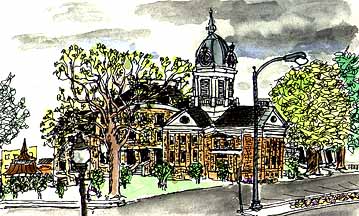
Monroeville Courthouse
The Monroe County Courthouse demands that we stop one more time,
and take her measure with ink and colors. A classic courthouse
square, with commercial blocks on the four sides, across wide
streets. The ornate clocktowered brick courthouse set among stately
live oaks and careful flowerbeds.
Our Sunday journey SHOULD begin at this storied courthouse. We
are going to follow traces of the Civil Rights Movement, and that
battle was fought in the courts as well as in the streets. In
this day when it’s easy to be cynical about special interest law
for those who can afford it, we may forget that a long struggle
for racial equality under the law began in petty courts like this,
and culminated in such decisions as Brown vs. Board of Education.
Harper Lee’s fictionalization of her father’s practice continues
to remind us that justice may be found in a courtroom, and that
Bull Connors isn’t the only Southern white archetype.
The Owl swoops toward Selma. The backroads seem very familiar
here. It could be Maine in July. The mix of pine and hardwoods,
new cars and beaters, gentle ridge and valley, good forest practice
and bad. We have the roads mostly to ourselves, and flush a pair
of turkeys somewhere near Beatrice. There are foothigh mounds
of dirt along the shoulders, like the works of giant prairie dogs,
but no residents in sight, unless the occasional roadkill armadillo
is a clue. The floral speciation is totally different, of course,
with many more compound leaves, and almost fernlike patterning,
longleaf pines vs. the whites of home.
Instead of the sagging clapboard capes of backroad Maine there
are rusty galvanized cabins with low eaves and deep porches, swallowed
in kudzu. Folks are gathered in the churchyards. One a desperate
old tin structure with a crooked steeple, and the cars lined up
under the trees in the dirt yard. But everyone in their Sunday
best, and most of the churches are as foursquare and tended as
any in New England.
There IS something shabbier about rural poverty in the South,
when you encounter it. It may be because the weather lets you
live in a place more exposed, or it may be the building materials.
A Maine house let go may lose its paint and look rustic, but galvanized
siding or cinderblock just gets rusty and dingy. There isn’t our
love of wickedgood paint out here in the kudzu.
Suddenly we’re driving over the Edmund Pettus Bridge, and back
into history. This is where Civil Rights marchers behind Martin
Luther King Jr. were stopped, and America was confronted, thanks
to a watching media. Another institution it’s easy to denigrate
now, but where would Dr. King and the others have been without
the press? How many of us remember that a French journalist was
killed at Ol’ Miss during the integration riots?
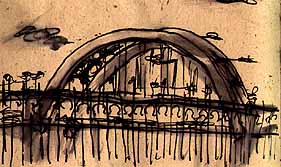
Edmund Pettus Bridge
This Sunday Selma is a ghost town. Wonderful ornate storefronts
empty and boarded up. Any downtown in New England as charming
as this would have a health food store, a bookstore, and a gang
of local artists. A place ripe for resurrection, but dozing in
the sun. A few fishermen idly twitching lures in the Alabama.
The low buzz of through traffic.
| We follow out Broad Street to the Visitor’s Center, and Peggy
gets a lecture on Disney Love Pops (“Americas best selling candy”),
and the other contemporary claims to fame. As well as a walking
tour guide and a map. There’s a four-block tour of voting rights
history, and Peggy makes the ritual moves, while I sketch the
AME Chapel in the third block, a twin-turetted brick bit of pride,
trimmed in white. |
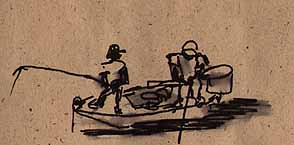
Fishin'
|
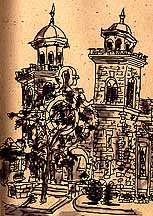
Brown Chapel
|
Across the street is a housing project. Long single-story brick
multiples. The streets and yards are full of kids and young men
making converse is the hot sun. One comes over to check out my
drawing. Tells me a halting tale of “a friend” who writes poems
“from the heart... Has a whole book full.” But can never get them
published. Can I make money with these drawings? I tell him probably
not. That isn’t what they’re for. That the doing is the thing.
That they’ll bring me back to this place, and this talk with him.
To tell his friend to keep the faith, and read his poems to everyone
who’ll listen. That’s what they’re for. |
“You a man with a vision,” he said.
This community had a vision 40 years ago. And it was in the church
congregations that those visions were organized. Selma has a wonderful
collection of brick-steepled churches, and is proud of more that
their architecture. Here again we tend to equate Southern churches
with reactionary politics and hidebound prejudices. We forget
that Dr. King was a preacher, and it was the churches of Selma,
black AND white, that mobilized for equal justice.
Do you remember the excitement? As a high school kid I was intoxicated
with the thought of a people rising up in a noble cause. Do you
remember noble causes?
Peggy strode out across the Edmund Pettus while I tried to make
a quick rendering. It was a revolutionary structure in its day,
a steel arch like the Hell Gate RR Bridge, approached by two leaping
cement arches. Another synapse where an idea crossed over, paradigms
shifted.
| We recrossed Edmund and followed the march route to Montgomery,
heart of the heart of Dixie. If you’ve gotta walk a highway, this
is a good’un. Running the ridgelines across rolling woodland and
pastures, it feels like the Taconic State in the Hudson Valley,
at least until you dump out into the paved exurb of the state
capitol. |
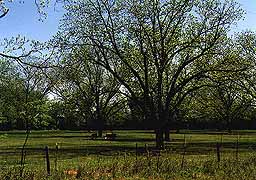
Pecans
|
The capitol city itself is shut down for the day, and scrubbed
down forever. They must have renewed the hell out of Montgomery.
It is as sterile a monument to bureaucracy as I’ve ever seen.
That ol’ George Wallace was something else. Every building is
lily-white. Except for the Dexter Avenue Baptist Church, Martin’s
church, just a few steps away from the capitol. This modest brick
antiquity must have been a thorn in the side of entrenched segregationist
power. Caddycorner to the Dept. of Justice, smack in front of
the rotunda stairs.
The Civil Rights Memorial is just around the corner, and you have
to credit the New South for honoring all of its past. Here in
the first capitol of the Confederacy, the big tourist attraction
is a black marble wall with flowing waters over a quote from Dr.King.
“..until justice comes flowing down like waters...”, and a black
sundial fountain memorializing the events and martyrs from Brown
v. Board to a day in Memphis. (And yesterday Coretta King met
with James Earl Ray and said she thinks he is innocent.) An all-white
gaggle of kids from Atlanta wearing T-s proclaiming “Faith Shout
Chorus” were playing around the waters, while an armed white security
guard watched, and their female black busdriver sat in the front
of the bus, smiling.
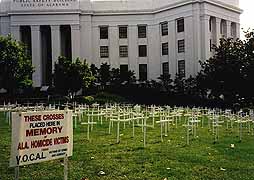
Homicide Protest
|
Political protest isn’t dead in Montgomery. The Justice department
lawn was covered with threefoot tall white crosses. Alabama homicide
victims in 1996. |
(Memo #79)
April 6 Selma & Montgomery
Who? Martin Luther King Jr., Rosa Parks, SNCC and SCLC leaders
What? cities at center of Civil Rights movement
Where? in central Alabama
When? 1950’s and 1960’s
How? a long series of events made them the focus of the civil
rights movement
Topics: Civil Rights Movement, Voting Rights Movement, integration,
protest marches, bus boycott
Questions: Why Selma? Why Montgomery? |
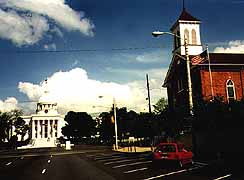
Montgomery
|
Selma and Montgomery, Alabama, are much more than places on a
map. They are icons of the civil rights movement, places memorialized
for the courage and dignity of marchers and protesters and boycotters.
Montgomery is identified with the bus boycott sparked by Rosa
Parks, and the state government lead by George and Lurleen Wallace.
Selma is identified with the voting rights movement and the march
on the capital. Many heroes of the Civil Rights Movement were
active in this part of Alabama: Martin Luther King Jr., John Lewis,
Hosea Williams, Stokeley Carmichael. SNCC, the SCLC. Some people
were killed during the Selma protests: James Reeb, Viola Liuzzo,
Jimmy Lee Jackson. Anyone over fifty will remember the stunning
pictures: the boycotters walking miles to work in Montgomery,
the line of marchers turned back at the Selma Bridge.
The more you delve into history, the more complex things appear.
You can’t start the Selma story in 1965 when the marches occurred
nor can you date Montgomery’s protests to the arrival of young
Martin Luther King. Blacks and whites had been actively promoting
civil rights in both cities since the Civil War and the passage
of the 13th, 14th, and 15th Amendments. For a brief time after
the Civil War blacks had many rights, these were destroyed by
the Jim Crow segregation system that arose in the late nineteenth
century. Protest has been continuous, from W.E.B. Du Bois and
the Niagara Movement through the establishment of the NAACP (1910),
the Urban League (1911) and CORE. CORE held sit-ins in Chicago
restaurants and skating rinks in the 1940’s! In the 1950’s and
1960’s the new leaders were in the SCLC, SNCC, the Black Panthers.
The movement heated up with the Supreme Court decision (Brown
V. Board of Education) in 1954 which outlawed segregation in education.
The Montgomery Bus Boycott (1955-56) was a test of segregation
in transportation; the Selma marches (1963) were a test of limited
voting rights. Chronologically, Montgomery came first, but we
started in Selma.
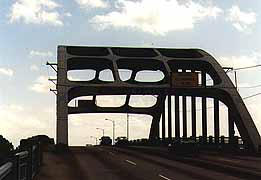
Over Troubled Water
|
We drove into Selma over the famous Edmund Pettus bridge. Downtown
is right on the other side with many empty lots and closed stores
with wrought iron trim and long verandas. The town center has
a number of beautiful stone churches, wide avenues, shaded residential
streets. Obvious redevelopment is underway with a small park by
the bridge, new brick sidewalks, and bright new historical markers.The
city has created a historic walking tour based on the 1965 marches
and there is a Voting Rights Museum.
|
| I took the walking tour which went down one side of King Street
a few blocks and back on the other side with information kiosks
every fifty yards - I walked by the George Washington Carver Housing
Complex (where civil rights workers trained and were housed),
Tabernacle Baptist (where the first mass meeting was held after
the ban), Brown AME chapel where King spoke, the alley which became
known as the Berlin Wall when police roped it off. Afterward I
walked across the Edmund Pettus Bridge. |
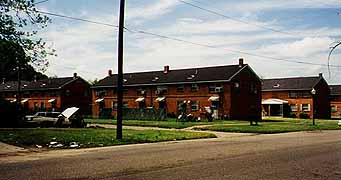
Housing Project
|
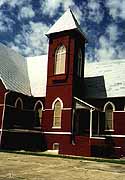
Selma
|
Why Selma? The city has been at the forefront of black activism
SINCE THE CIVIL WAR. In 1867 Selma had a black policeman. The
first black congressman in the nation (Benjamin S. Turner) was
elected from Selma in 1870, followed by Representative Jeremiah
Haralson in 1874 (who later became the first black Republican
National committeeman). The county elected a black judge in 1874.
The first African Methodist church in Alabama is in Selma, and
several black colleges. The county had a large number of black
voters in the late nineteenth century. Then in 1901 the Alabama
legislature greatly limited voting eligibility and the number
of registered black voters in Dallas County declined from 9871
to 52 (!) . That was really the beginning of the Voting Rights
Movement. |
| The Dallas County Voters League (DCVL) was established in the
1930’s and its board kept the pressure on officials. In 1963 SNCC
came into Selma to help with voter registration. Mass meetings
were held. In July a local judge prohibited all mass meetings.
The DCVL invited Dr. King and the Southern Christian Leadership
Council (SCLC) to help. On January 2, 1965, Dr. King defied the
judge’s order with a mass meeting at Brown AME church and marches
were planned. Three marches took place in Selma, the third culminating
in the walk from Selma to Birmingham. During the First march on
March 7, 500 protester were met at the bridge by gungho Sheriff
Clark and his cops. When the crowd was ordered to disperse and
didn’t, the cops attacked and 65 people were injured. Dr. King
called a ministers’ walk for March 9th. It was turned back. Increasing
media attention focused on the city. On Sunday March 21, 3000
marchers successfully crossed the Pettus bridge. 300 continued
on to Montgomery and arrived there five days later. |
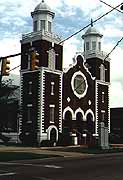
Brown Chapel
|
“Selma Alabama became a shining moment in the conscience of man”
- Martin Luther King Jr.
We left Selma by the Pettus bridge and drove the fifty miles to
Montgomery, following the route the marchers had taken in 1965.
I had no image of the actual road and found that it is beautiful,
The highway is divided and goes through rolling green farm lands.
Montgomery is a gutted city, razed by urban redevelopment. Decaying
neighborhoods greeted us, then wide empty boulevards and vacant
lots and spanking clean government buildings. Montgomery was quiet
and empty on a Sunday afternoon. We easily found the heart of
the city: the huge imposing domed state capital with Martin Luther
King’s brick Dexter Street church right across the street ! I
had no idea. King’s church is as close to the capital steps as
Blaine House is to the Maine statehouse! What a thorn in the side
of the segregationists in government Dr. King must have been.
It is not obvious today where Dr. King’s congregation came from.
There is no neighborhood near to the Dexter Street church today.
| The Civil Rights monument is only a block away, in front of the
Southern Poverty Law Center. Maya Lin designed a round black marble
“table” inscribed with the names of all who died in the modern
Civil Rights Movement. The table is an off center cone with its
apex in the ground. Water flows evenly from the center of the
table to the edge and then surface tension holds it under and
down the undercut slope. Behind the table a wall of water washed
a quote from Dr. King. Both images (table and water) have Biblical
allusions. The monument is smaller than I expected, human scale,
very beautiful. White teenagers from a Praise Shout Choral Tour
were dabbling their hands in the fountain. |
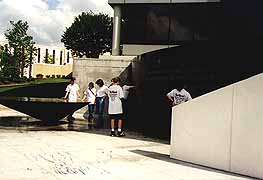
Civil Rights Monument
|
Montgomery also had a long tradition of active protesters. A women’s
group had been working for civil rights and Rosa Parks was part
of the local NAACP. In 1955 young Martin Luther King Jr. became
minister of the Dexter Street Church. When Rosa Parks refused
to give up her seat in the front of a Montgomery bus to a white
man, and was arrested, King helped organize the Montgomery bus
boycott. It lasted almost a year.
The bald facts (marches turned back, a one-year boycott) don’t
convey the feelings and hardships of those involved. A minister
from Boston (James Reeb) was beaten to death in Selma, a young
man (Jimmie Lee Jackson) and a woman protester from Detroit (Viola
Liuzzo) were shot. Many others were injured by police clubs -
broken bones, huge bruises, heads cracked open, pain. In Montgomery
blacks organized car pools and walked long distances to and from
work. Some workers had to leave home before dawn to make their
commute. The summer heat in Alabama on a three mile walk after
a full workday must have been devastating, but the boycott endured.
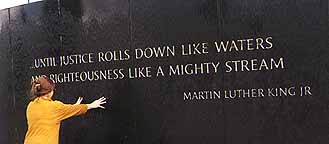
Memorial
The outcomes of Montgomery? The buses were integrated, followed
(during the protest years) by restaurants and pools and stores
and motels. Driving through the South today you are not aware
of segregation except in the distinct residential neighborhoods.
The outcome of Selma? In 1965 President Lyndon Johnson signed
the Voting Rights Act to guarantee suffrage to citizens. A 1968
Act reinforced the broad Civil Rights Act of 1964 barring discrimination
in employment and public accommodations. Sheriff Clark was defeated
in the 1966 election. In 1972 blacks were on the Selma City Council
and in 1988 blacks had the majority of seats on the Selma County
Commission. Selma tourist information lauds the black history
of the city and the Historic Walking Tour of the voting rights
movement is the best marked area we’ve seen in Alabama. Traveling
through the South shows a publicly integrated society.
We had one last stop which added to our picture of the civil rights
struggle. Thirty miles east of Montgomery is Tuskegee University,
the black university established by Booker T. Washington. Washington
is a controversial figure today because he accepted the notion
of “gradualism” (slow integration) and trained black for vocational
trades. Yet the university he established seems to be the center
of a strong black professional community. The campus is huge and
beautiful, brick buildings dot the hills and winding paths link
them. There are huge shade trees and lawns and small ponds. Construction
is going on in several parts of the campus. The buildings show
the breadth of curriculum from the liberal arts to education and
forestry. It looks like any large liberal arts college. Every
adult and coed, every storekeeper we saw in Tuskegee was black.
My first teaching experience was at Hampton University, a black
college in Hampton, Virginia, where I became aware of the ease
there is for minorities in a minority dominated school, where
the role models are mostly black and the campus organizations
are run by blacks. The traditional black schools (Vanderbilt,
Spellman, many A&Ms, Hampton, Tuskegee) have gone through cycles
of change. Since the 1960’s, black academics and high school stars
have been courted by white universities, but Tuskegee and Hampton
(which we revisited in Virginia) show that black colleges are
very much alive today. They may be the strongest training centers
for black professionals and political leaders.
Selma, Montgomery, Tuskegee. We ended the day with a feeling of
hope.
4/6.. contd.
We beat feet.. or wings. Got swept up onto the interstate, and downloaded immediately
at a fresh produce mart. Scanned in some veggies and fruit. Local
vine ripe tomatoes in April. They say that it gets too hot after
May for tomatoes, if you can believe it. Then we ambled along
byways to Tuskeegee.
Tuskeegee is a big University, sprawling down a wooded ridge,
and busy with new construction on its margins. The Booker T. Washington
Museum was closed, naturally, in the Sunday style, but Booker
has been badly debunked since he was the hero of our PC texts
in the 50s. Favored gradualism and trade school education... all
that stuff that got Xed by Malcolm.
The Owl fluttered around and about the campus.. basic college
scene, except totally black. Peggy has been taking van-loads of
prospective students on college tours for years, and has a keen
eye for institutional detail. She was impressed by the depth of
facilities, and smiled at the frat houses and sororities.
High speedbumps made our springs squeak, and the maze of roadways
kept ending at a locked gate. As usual I ignored the Thou Shalt
Nots and squeezed down sidewalks and byways, only to be foiled
at every turn. Began to turn a little pink when the undergrads
started watching us closely. I started to suspect the labyrinth
was designed to confuse hostile invasions. Like the Brits removing
all the roadsigns during WWII.
We made it to Dunkirk, and proceeded toward the Georgia line.
Another indepth state tour: Alabama in 60 hours. Lilian to Phenix
City. If our snoop gives good poop, the Heart of Dixie could steal
yours, in April. The most beautiful country we’ve seen since leaving
Maine, this time.
Our pit stop at sabbath’s end was in Columbus, Georgia, close
to the sports complex: 5 (?) stadia all clumped together. I felt
so athletic I went walking along the riverside amenity, which
runs for 18 miles. I didn’t, but enjoyed ambling beside the Chattahoochee,
with folks fishing on the sandy margin, cyclists whizzing past,
and fellow walkers inhaling the thick sweet fragrance of the chinaberry
trees in bloom. Millions of little purple flowers, whose first
whiff reminds you of some flavored pipe tobacco, then the full
fruity aroma floods your blood sugar. I went back to the cabana
where Peggy was doing laps and waved the checkered flag at her.













